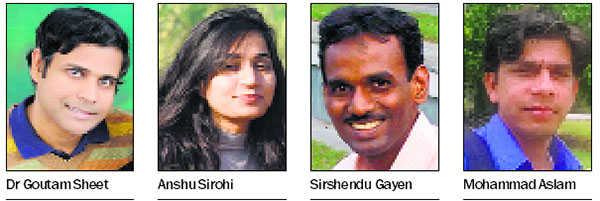
Bhartesh Singh Thakur
Tribune News Service
Chandigarh, December 10
Scientists at the Indian Institute of Science Education and Research (IISER), Mohali, have achieved superconductivity in silicon at a temperature more than 10 Kelvin (-263.15° Celsius).
Before this, superconductivity in silicon was shown to exist at a very low temperature — 0.35 Kelvin (-272.8° Celsius).
The journal — Applied Physics Letters — has accepted the paper of Anshu Sirohi, Dr Sirshendu Gayen, Dr Mohammad Aslam and Dr Goutam Sheet from IISER. Sirohi is a PhD student.
Todays’s digital age is also referred to as the “Silicon Age”. Silicon is the most widely used material in the semiconductor industry because of its ability to induce novel electronic properties in this material through doping.
“Inducing other electronic phases like superconductivity in silicon has been a much coveted goal,” said Dr Sheet, who heads the IISER team.
Superconductivity is a phenomenon of zero electrical resistance below a critical temperature. In such a state, the current flows through a superconducting loop indefinitely without any power source.
Dr Sheet added: “Theoretically, the possibility of superconductivity in silicon under certain special conditions had not been ruled out. Consequently, research scientists all over the world have been trying to make silicon superconducting following several routes which include applying a huge pressure or the non-trivial doping.”
Some success in the direction was obtained when superconductivity in silicon was shown to exist at low temperatures of 0.35 Kelvin by abusing silicon with high energy and expensive laser-plasma-based techniques.
“We have developed an innovative, simple and cheap method of inducing superconductivity in commercially-available silicon crystals,” said Dr Sheet. The team discovered that if the surface of silicon is touched with a sharp needle of metal, the point of contact becomes superconducting at a remarkably high temperature of 10 Kelvin.
“It is expected that the discovery will revolutionise the superconducting nano-electronics industry,” said Dr Sheet.
“It is a remarkable achievement,” said Prof Navdeep Goyal, Chairperson, Department of Physics, Panjab University (PU).
Earlier, Dr Sheet’s team made microscopic contacts of pure silver on a novel material cadmium arsenide and discovered that the point of contact behaved like a superconductor. It was published in Nature Journal in 2015. Neither silver nor cadmium arsenide is superconducting on its own, but their junction becomes one. The superconducting phase was achieved at -265° Celsius.



























